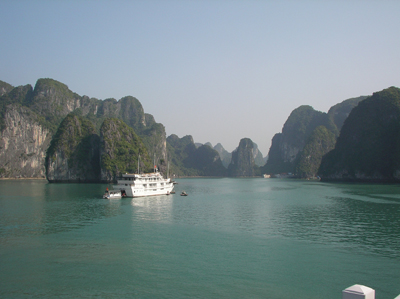Air pollution in Southeast Asia
This item appears on page 25 of the February 2016 issue.
My husband, Jack, and I traveled to Vietnam and Cambodia, Jan. 14-Feb. 3, 2015, and were shocked at the extreme amount of air pollution we encountered almost everywhere we went.
We arrived in Hanoi late at night. The next morning, after a spectacular buffet breakfast at the lovely Hotel Metropole Hanoi (15 Ngo Quyen St., Hoan Kiem District; www.sofitellegend.com), we met our guide and ventured outside. The streets were rivers of motorcycles rushing by.
The sky was a steely gray, and there was a gritty quality to the air. Our eyes soon began to burn and our throats became sore. The plant life in the parks seemed lusterless and the bird life was limited.
Jack and I had anticipated walking all over the city, but this wasn’t pleasant due to the air quality and the onslaught of motorcycles. There were no traffic lights to help pedestrians cross the streets. Even with the help of our guide, it was anything but relaxing.
On the 4-hour drive to Ha Long Bay, we hoped to escape the air pollution and see some beautiful countryside. However, along the way, we weren’t far from coal refineries belching fumes.
The air pollution did let up somewhat at Ha Long Bay, but it was still noticeable. Although the area retains some natural beauty, it’s full of tourists. For those who envision a peaceful experience in nature, this isn’t it.
For this trip to Southeast Asia, Jack and I had gathered information from the Internet and guidebooks and made the plans, ourselves. We made choices in great detail. It turned out that knowing exactly what we wanted to see was necessary in obtaining bids from the private guides and drivers.
Once we decided on the details, we went to Margreet Pettersen of Bainbridge Travel (Bainbridge Island, WA; 800/550-0135 or 206/780-5010, http://bainbridgetravel.com), who has been a wonderful travel agent for us for many years. She booked our flights (international and from Hanoi to Da Nang), our Ha Long Bay cruise and a Mekong River cruise.
Margreet contacted Goway’s Asia experts to design a package for us, including all transfers between hotels, cruise ships and planes. Goway (www.goway.com) did an outstanding job. All connections went smoothly, our vehicles were comfortable and air-conditioned, and our guides and drivers were excellent. We appreciated that our guides really did speak English.
So it was just the two of us with the guides, but we were with groups when we went on excursions in Ha Long Bay and on the Mekong.
For Ha Long Bay, we had chosen the 3-day, 2-night cruise with Paradise Cruises (Hanoi, Vietnam; www.paradisecruises.vn). Margreet checked it out before booking us on it. The ship Paradise Luxury was comfortable, but the excursions were crowded. Our visit to a large cave was among hundreds of other tourists milling around numerous stalls with cheap souvenirs for sale.
We returned to Hanoi and flew to Da Nang. From the air, we could see a dense, dark layer of pollution over the city. Our lovely destination, the Victoria Hoi An Beach Resort & Spa (Cua Dai Beach, Hoi An Town; www.victoriahotels.asia/en/hoi-an), itself, couldn’t have been nicer.
Sadly, again we were depressed by the air pollution, which made it hard to enjoy the beach or pool. Being outdoors was simply not pleasant. Our best time in Vietnam was a day trip to Bach Ma National Park, a French-era hill station well worth the 3-hour drive from Hoi An.
Up in the mountains, the difference was dramatic. We felt good again! It was a great pleasure to walk along some paths and savor the view at the mountaintop.
Siem Reap, Cambodia, was our next stop, as visiting the complexes of the Angkor Wat area was the inspiration for our trip. The air pollution continued, though not as bad as in Hanoi. We spent three days exploring various temple complexes. It was fascinating but a challenge due to the heat and the many steep steps.
The last part of our trip was a week-long Mekong River cruise aboard the AmaLotus of AmaWaterways (Calabasas, CA; 866/626-0110, www.amawaterways.com). That area had less air pollution than Hanoi, but it was still there. We are birders and had our binoculars in hand but saw remarkably little bird life along the river. We found the scenery not particularly lush but rather flat and boring.
There was an enormous amount of pollution in the river. Hundreds of people live in floating villages on bamboo platforms with very modest houses on them. The waste from all these homes goes directly into the river.
In Ho Chi Minh City, the air pollution was extremely unpleasant.
By the end of three weeks, our throats were very sore and we were coughing frequently, as were many of our fellow passengers. Although most Vietnamese are poor, we noticed that everywhere we went, some were wearing face masks, an extra expense of daily life.
We know that the benefits of economic progress are very important to the Vietnamese and Cambodians. Several natives spoke to us most eloquently about how happy they were now that their children weren’t starving.
The immediate benefits of having enough food to eat, clothes to wear and a decent place to live are, understandably, a higher priority than the longer-term benefits of clean air. But air pollution is already impacting Vietnam with rapidly increasing medical costs for pollution-related illnesses.
I have to ask myself about my responsibility as a visitor. Is it right for me to spend my tourist dollars in places where the air pollution presents a health hazard?
Tourism is a valuable source of income in Vietnam and Cambodia. If people chose not to visit because of air pollution, consequently withholding that income, would steps be taken to reduce pollution?
JEAN SARGENT
Bainbridge Island, WA


